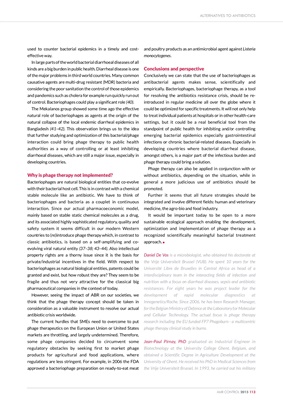
used to counter bacterial epidemics in a timely and costeffective
way.
In large parts of the world bacterial diarrhoeal diseases of all
kinds are a big burden in public health. Diarrheal disease is one
of the major problems in third world countries. Many common
causative agents are multi-drug resistant (MDR) bacteria and
considering the poor sanitation the control of those epidemics
and pandemics such as cholera for example run quickly run out
of control. Bacteriophages could play a significant role (40).
The Mekalanos group showed some time ago the effective
natural role of bacteriophages as agents at the origin of the
natural collapse of the local endemic diarrheal epidemics in
Bangladesh (41-42). This observation brings us to the idea
that further studying and optimization of this bacterial/phage
interaction could bring phage therapy to public health
authorities as a way of controlling or at least inhibiting
diarrhoeal diseases, which are still a major issue, especially in
developing countries.
Why is phage therapy not implemented?
Bacteriophages are natural biological entities that co-evolve
with their bacterial host cell. This is in contrast with a chemical
stable molecule like an antibiotic. We have to think of
bacteriophages and bacteria as a couplet in continuous
interaction. Since our actual pharmacoeconomic model,
mainly based on stable static chemical molecules as a drug,
and its associated highly sophisticated regulatory, quality and
safety system it seems difficult in our modern Western
countries to (re)introduce phage therapy which, in contrast to
classic antibiotics, is based on a self-amplifying and coevolving
viral natural entity (37-38; 43-44). Also intellectual
property rights are a thorny issue since it is the basis for
private/industrial incentives in the field. With respect to
bacteriophages as natural biological entities, patents could be
granted and exist, but how robust they are? They seem to be
fragile and thus not very attractive for the classical big
pharmaceutical companies in the context of today.
However, seeing the impact of ABR on our societies, we
think that the phage therapy concept should be taken in
consideration as a valuable instrument to resolve our actual
antibiotic crisis worldwide.
The current hurdles that SMEs need to overcome to put
phage therapeutics on the European Union or United States
markets are throttling, and largely undetermined. Therefore,
some phage companies decided to circumvent some
regulatory obstacles by seeking first to market phage
products for agricultural and food applications, where
regulations are less stringent. For example, in 2006 the FDA
approved a bacteriophage preparation on ready-to-eat meat
and poultry products as an antimicrobial agent against Listeria
monocytogenes.
Conclusions and perspective
Conclusively we can state that the use of bacteriophages as
antibacterial agents makes sense, scientifically and
empirically. Bacteriophages, bacteriophage therapy, as a tool
for resolving the antibiotics resistance crisis, should be reintroduced
in regular medicine all over the globe where it
could be optimized for specific treatments. It will not only help
to treat individual patients at hospitals or in other health-care
settings, but it could be a real beneficial tool from the
standpoint of public health for inhibiting and/or controlling
emerging bacterial epidemics especially gastrointestinal
infections or chronic bacterial-related diseases. Especially in
developing countries where bacterial diarrheal disease,
amongst others, is a major part of the infectious burden and
phage therapy could bring a solution.
Phage therapy can also be applied in conjunction with or
without antibiotics, depending on the situation, while in
general a more judicious use of antibiotics should be
promoted.
Further it seems that all future strategies should be
integrated and involve different fields: human and veterinary
medicine, the agro-bio and food industry.
It would be important today to be open to a more
sustainable ecological approach enabling the development,
optimization and implementation of phage therapy as a
recognized scientifically meaningful bacterial treatment
approach. l
Daniel De Vos is a microbiologist, who obtained his doctorate at
the Vrije Universiteit Brussel (VUB). He spent 10 years for the
Université Libre de Bruxelles in Central Africa as head of a
interdisciplinary team in the interacting fields of infection and
nutrition with a focus on diarrheal diseases, sepsis and antibiotic
resistances. For eight years he was project leader for the
development of rapid molecular diagnostics at
Innogenetics/Roche. Since 2006, he has been Research Manager,
for the Belgian Ministry of Defence at the Laboratory for Molecular
and Cellular Technology. The actual focus is phage therapy
research including the EU funded FP7 Phagoburn - a multicentric
phage therapy clinical study in burns.
Jean-Paul Pirnay, PhD graduated as Industrial Engineer in
Biotechnology at the University College Ghent, Belgium, and
obtained a Scientific Degree in Agriculture Development at the
University of Ghent. He received his PhD in Medical Sciences from
the Vrije Universiteit Brussel. In 1993, he carried out his military
ALTERNATIVES TO ANTIBIOTICS
AMR CONTROL 2015 113